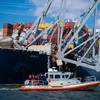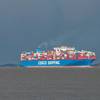International classification society Bureau Veritas has been chosen
to class the 153,500 cu m LNG carrier ordered by Gaz de France from
Chantiers de l'Atlantique this week. This is the largest ever LNG carrier
and is due for delivery in 2005. The order includes an option for a second
vessel. BV helped develop the concepts for the vessels, and developed unique
new rules to allow the yard and owners to break new technological frontiers.
"BV has consistently been the world leader in LNG carriage, since
development of membrane LNG carriers was first begun," says Bruno Dabouis,
commercial manager of BV's marine division. "Now we will class these new
vessels, which are a quantum leap forward in cost-effective LNG
transportation. The innovative features in these ships will set the
benchmark for the rest of the world to live up to."
The ships have two key innovations. The traditional steam turbine plant will
be replaced by a low-pressure dual fuel diesel electric system, and the
cargo gas will be carried in the new GTT CS1 membrane system.
BV co-operated with Wärtsilä for the development of the safety concept of
the low-pressure dual fuel diesel/gas engine, and has issued new rules for
such engines. These are unique, and set new standards for this type of
machinery plant.
BV also co-operated with GTT on the complex calculations and modeling
needed to develop the cost-effective CS1 containment system. CS1 was granted
BV concept approval in 2002.
The dual fuel diesel electric propulsion system offers several advantages.
As a more compact installation, it allows the shipyard to maximize cargo
space in the hull. It will reduce gas consumption compared to the
conventional turbine installations. Operators will have more flexibility
with respect to crewing, as engineers familiar with turbine installations
are now in short supply. Maintenance is simplified as generator sets can be
taken off line and maintained on passage. Machinery redundancy is enhanced,
cutting the risk of a power failure.
The CS1 containment system combines the best features of the proven Mark III
and NO96 membrane systems. It offers increased strength, faster fabrication,
and a cost reduction of 15 per cent compared to existing systems. Partial
loading conditions are also possible, improving operational flexibility.
Sponsored Content
Chris-Marine’s solutions help to prolong engine lifetime

AST is now AST Networks, bringing you remote connectivity wherever you are

March 2024
 Read the Magazine
Read the Magazine

 Read the Magazine
Read the Magazine
This issue sponsored by:

Tip #57: Cybersecurity in Maritime Operations and Training
Subscribe for
Maritime Reporter E-News
Maritime Reporter E-News is the maritime industry's largest circulation and most authoritative ENews Service, delivered to your Email five times per week












